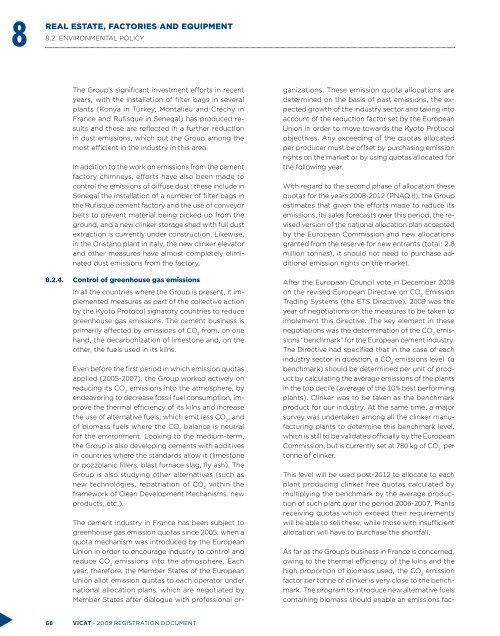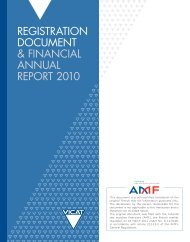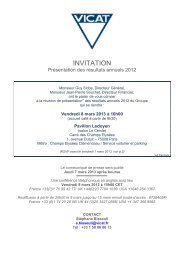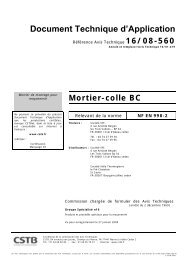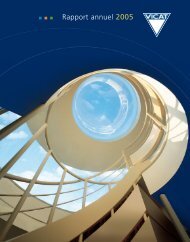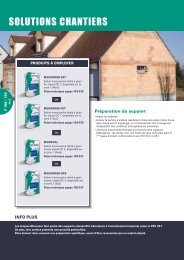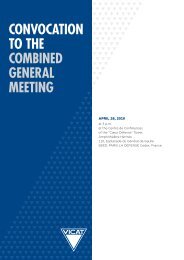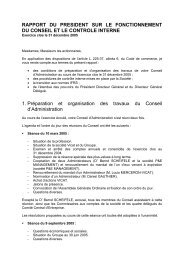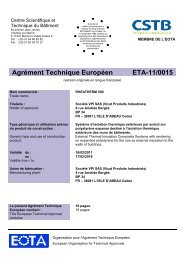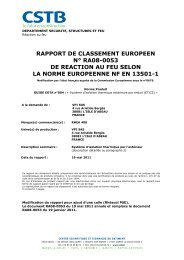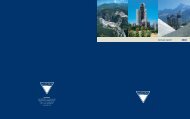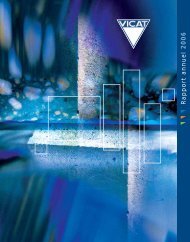6 - Vicat
6 - Vicat
6 - Vicat
- No tags were found...
You also want an ePaper? Increase the reach of your titles
YUMPU automatically turns print PDFs into web optimized ePapers that Google loves.
8Real estate, factories and equipment8.2. ENVIRONMENTAL POLICYThe Group’s significant investment efforts in recentyears, with the installation of filter bags in severalplants (Konya in Turkey, Montalieu and Créchy inFrance and Rufisque in Senegal) has produced resultsand these are reflected in a further reductionin dust emissions, which put the Group among themost efficient in the industry in this area.In addition to the work on emissions from the cementfactory chimneys, efforts have also been made tocontrol the emissions of diffuse dust : these include inSenegal the installation of a number of filter bags inthe Rufisque cement factory and the use of conveyorbelts to prevent material being picked up from theground, and a new clinker storage shed with full dustextraction is currently under construction. Likewise,in the Oristano plant in Italy, the new clinker elevatorand other measures have almost completely eliminateddust emissions from the factory.8.2.4. Control of greenhouse gas emissionsIn all the countries where the Group is present, it implementedmeasures as part of the collective actionby the Kyoto Protocol signatory countries to reducegreenhouse gas emissions. The cement business isprimarily affected by emissions of CO 2from, on onehand, the decarbonization of limestone and, on theother, the fuels used in its kilns.Even before the first period in which emission quotasapplied (2005-2007), the Group worked actively onreducing its CO 2emissions into the atmosphere, byendeavoring to decrease fossil fuel consumption, improvethe thermal efficiency of its kilns and increasethe use of alternative fuels, which emit less CO 2, andof biomass fuels where the CO 2balance is neutralfor the environment. Looking to the medium-term,the Group is also developing cements with additivesin countries where the standards allow it (limestoneor pozzolanic fillers, blast furnace slag, fly ash). TheGroup is also studying other alternatives (such asnew technologies, repatriation of CO 2within theframework of Clean Development Mechanisms. newproducts, etc.).The cement industry in France has been subject togreenhouse gas emission quotas since 2005, when aquota mechanism was introduced by the EuropeanUnion in order to encourage industry to control andreduce CO 2emissions into the atmosphere. Eachyear, therefore, the Member States of the EuropeanUnion allot emission quotas to each operator undernational allocation plans, which are negotiated byMember States after dialogue with professional organizations.These emission quota allocations aredetermined on the basis of past emissions, the expectedgrowth of the industry sector and taking intoaccount of the reduction factor set by the EuropeanUnion in order to move towards the Kyoto Protocolobjectives. Any exceeding of the quotas allocatedper producer must be offset by purchasing emissionrights on the market or by using quotas allocated forthe following year.With regard to the second phase of allocation thesequotas for the years 2008-2012 (PNAQ II), the Groupestimates that given the efforts made to reduce itsemissions, its sales forecasts over this period, the revisedversion of the national allocation plan acceptedby the European Commission and new allocationsgranted from the reserve for new entrants (total : 2.8million tonnes), it should not need to purchase additionalemission rights on the market.After the European Council vote in December 2008on the revised European Directive on CO 2EmissionTrading Systems (the ETS Directive), 2009 was theyear of negotiations on the measures to be taken toimplement this directive. The key element in thesenegotiations was the determination of the CO 2emissions“benchmark” for the European cement industry.The Directive had specified that in the case of eachindustry sector in question, a CO 2emissions level (abenchmark) should be determined per unit of productby calculating the average emissions of the plantsin the top decile (average of the 10 % best performingplants). Clinker was to be taken as the benchmarkproduct for our industry. At the same time, a majorsurvey was undertaken among all the clinker manufacturingplants to determine this benchmark level,which is still to be validated officially by the EuropeanCommission, but is currently set at 780 kg of CO 2pertonne of clinker.This level will be used post-2012 to allocate to eachplant producing clinker free quotas calculated bymultiplying the benchmark by the average productionof such plant over the period 2006-2007. Plantsreceiving quotas which exceed their requirementswill be able to sell these, while those with insufficientallocation will have to purchase the shortfall.As far as the Group’s business in France is concerned,owing to the thermal efficiency of the kilns and thehigh proportion of biomass used, the CO 2emissionfactor per tonne of clinker is very close to the benchmark.The program to introduce new alternative fuelscontaining biomass should enable an emissions fac-68 VICAT - 2009 registration document


